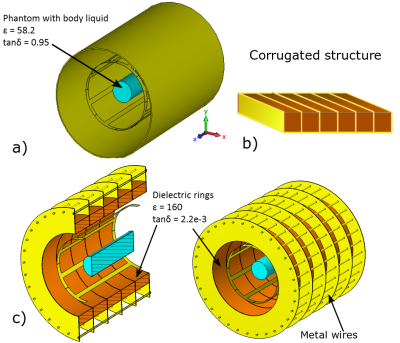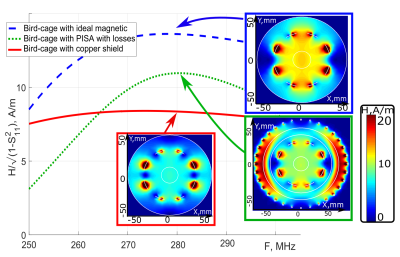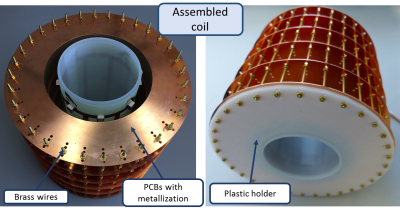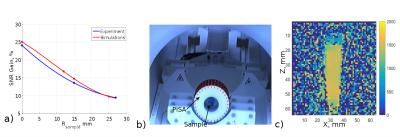0754
Experimental Characterization of Artificial Magnetic Shield for Improvement of Small-Animal Birdcage at 7 T1Faculty of Physics and Engineering, ITMO University, St.Petersburg, Russian Federation, 2CNRS, Centrale Marseille, Institut Fresnel, Aix Marseille Univ, Marseille, France, 3CEA-Saclay, DRF/I2BM/Neurospin/UNIR, Université Paris-Saclay, Gif-sur-Yvette Cedex, Paris, France, 4CNRS, CRMBM, Aix Marseille Univ, Marseille, France, 5Department of Electronics and Nanoengineerin, AALTO University, AALTO, Finland, 6Biomedical Engineering, Eindhoven University of Technology, Eindhoven, Netherlands
Synopsis
We proposed a practical realization of an artificial shield for a small-animal birdcage coil for 7T MRI based on a cylindrical miniaturized corrugated structure, which demonstrates the property of a constructive interference inside the coil. The presence of a conventional metallic shield around the birdcage significantly limits the coil efficiency because of the destructive interference between the magnetic field of the shield and the primary field of the coil in the subject. We numerically and experimentally demonstrated that the proposed structure placed around the birdcage could increase the efficiency for relatively small samples due to its in-phase reflection.
Introduction
In any MRI system radio-frequency (RF) birdcage volume coils are used for RF excitation and often also for reception of signals. An important part of such coils is a metal RF-shield tightly surrounding the birdcage conductors. However, due to out-of-phase reflection from the metal there is the destructive interference with the shield currents, which may limit the power efficiency and SNR [1]. Artificial structures such as metal corrugated structures can be used as artificial magnetic shields (AMS) to improve the radiation efficiency and the shape of a radiation pattern of antennas in the microwave range [2]. Miniaturized high-impedance surfaces were proposed to improve the performance of surface loops [3] and dipole arrays [4] for UHF MRI. Split-ring shields have been shown to improve SAR and homogeneity of a birdcage [5]. In this work we discuss the possibility to improve the power efficiency and SNR of a birdcage loaded with a small sample. A birdcage for preclinical MRI at 7T was numerically simulated in the presence of a surrounding AMS based on a cylindrical corrugated structure filled with a high-permittivity dielectric material. This case was compared with the same coil equipped with a conventional copper and an ideal perfect magnetic conductor (PMC). The experimental setup was assembled and tested through on-the-bench measurements and also on a 7T MRI system. The purpose of this paper is to develop a practical implementation of an AMS for a birdcage and experimentally demonstrate the improving the coil receive and transmit performance in the case of small subjects.Methods
Numerical simulations were made using CST Microwave Studio 2017. Simulation model of the preclinical birdcage for 7T 19F MRI contained a homogeneous cylinder phantom with the length 80mm, radius 11.5mm and material properties of σ=0.95S/m, ε=58. The simulated high-pass 8-leg birdcage had the radius 36mm and driven by single port. As the reference coil we considered the birdcage with copper shield having radius 57mm, as it is shown in Fig1(a). Simulation setup of the proposed coil configuration and its cross-section are shown at Fig1(c). Conventional shield was replaced by a cylindrical miniaturized corrugated structure (Fig1(b)), which was implemented as an array of metal corrugations periodic in Z-direction. The corrugations were partially filled with low-loss high-permittivity dielectric (tanδ=0.0022S/m, ε=160), inner radius of the dielectric ring was 47mm, height was 11mm and length of every ring was 26mm. The external metallic surface was represented as a periodic array of 32 metallic wires, to make it easier to build and to avoid eddy currents. To compare the performance of the reference shield with our approach, the efficiency values were calculated as absolute value of the H-field in the center of the phantom normalized to the accepted power. Comparison of the efficiency and B1+ maps in the central axial plane is shown on Fig2.To assemble the experimental setup, the five high-quality ceramic CaTiO3 rings were manufactured with the dimensions and properties as in the simulations. Metallic slices of the corrugations were printed on solid PCBs, placed between cylinders and fixed by 32 brass wires (Fig 3). The birdcage was implemented as a thin flexible PCB with printed conductors and solded end-ring capacitors fixed on a polycarbonate tube. The birdcage coil was driven in a linear polarization regime by connecting to the 1st port of a VNA. To experimentally measure the efficiency, a small loop was used as a probe with 2nd port and was placed inside a phantom filled with body liquid. S12 and S11 coefficients were measured by VNA. Efficiency of the proposed and reference birdcages were found in the frequency range from 250 to 300MHz as S12= S12/√(1- S112) for different phantom sizes. An assembled setup was tested in 7T Siemens scanner (CEA, France) at 19F (Fig4(b)). XFL Amplitude of CP mode, maximum value is 1500 = 150o (Ref 40V) was measured. Water sample radius Rsample=27mm contained fluorine was used. Obtained B1+ map is homogeneous inside the sample, so that the correct mode was exited.
Results and Conclusion
The effect of the proposed AMS replacing a conventional copper one was numerically studied. The proposed AMS based on a miniaturized cylindrical corrugated structure was shown to behave similarly to PMC surrounding the same birdcage. The simulations showed that the axial H-field pattern in the sample holds homogeneous when replacing the copper shield with the PMC one and in the case of the proposed artificial shield. These results clearly show that the proposed structure has a similar effect to the transmit field in the region of interest as the PMC shield and enhances the transmit efficiency of the birdcage for small samples(Fig2). But since in the real structure we had some losses in the ceramics, the efficiency dropped down, but still it was about 25% better then reference birdcage. The practical realization of a magnetic shield based on the miniaturized corrugated surface was manufactured (Fig3). Simulations were proven by on-bench experiments by measuring the efficiency of the proposed and reference coils (Fig4(a)). Simulations and experiments showed that when the sample becomes sufficiently large, almost no improvement was observed. Also, the proposed coil was tested in MRI scanner and homogeneous B1+ map was obtained.Acknowledgements
This project has received funding from the European Union’s Horizon 2020 research and innovation program under grant agreement no 736937.
This work is supported by the President of the Russian Federation (МК-3620.2019.8).
References
[1] CM Collins et al., A Method for Accurate Calculation of B1 Fields in Three Dimensions. Effects of Shield Geometry on Field Strength and Homogeneity in the Birdcage Coil. J. Magn. Reson., 125(2), 233-241, 1997.
[2] P.-S. Kildal et al., Artificially soft and hard surfaces in electromagnetics. IEEE TAP, vol 38(10), 1990
[3] Z. Chen et al., Efficiency and Signal-to-Noise-Ratio of a Surface Coil by a High-Impedance-Surface RF Shield for 7-T Magnetic Resonance Imaging, IEEE Trans. Micr. Theor. Tech., vol. 65(3), pp. 988-997, 2017.
[4] Daniel Erni et al., Multi-functional RF coils for ultra-high field MRI based on 1D/2D electromagnetic metamaterials, J. Phys.: Conf. Ser. 1092 012031, 2018.
[5] Carel Costijn van Leeuwen et al., Split-Ring-Resonator shield improves SAR efficiency and homogeneity of birdcage antenna. ISMRM 2019
Figures



